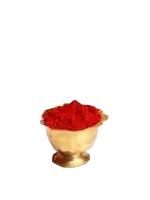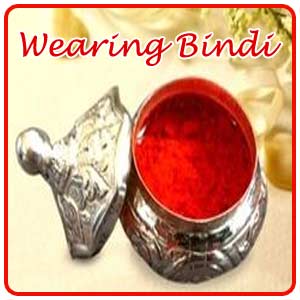 History Of Wearing Bindi
History Of Wearing Bindi
The people of South East Asian countries are very much attached to the concept of Bindi which is a small or a big dot worn in the forehead between the eyebrows and this particular spot is considered to be a major nerve point in human body since olden days. This ornamental mark is also considered to be of great cultural importance especially by the people of Hindu community. It adds to the visual fascination of the body and is also referred by other names like 'pottu', 'sindoor', 'tilak', 'tilakam', and 'kumkum'. This ornamental mark is usually made with red colour and in North India it is an indispensible custom among the married woman whereas in South India girls choose to wear different kinds of bindi.
 Bindi is Considered to be a Propitious Sign of Marriage
Bindi is Considered to be a Propitious Sign of Marriage
-Bindi is considered to be a propitious sign of marriage and provides an assurance to the social status and holiness of the institution of marriage. According to the Indian customs and traditions a bride usually steps out of her parents place not only with glittering apparels and ornaments but also with a bright red bindi on her forehead. This sign of bindi on the brides forehead is believed to grant prosperity and progeny to her family. Though lot of artificial bindis has come up now, traditionally it was a pinch of vermilion powder applied skillfully with practiced fingertip which make the perfect dot. These traditional vermilion powders are usually red or maroon in colour. These bindis get their shape with the help of small circular discs where first a sticky wax paste is applied on the forehead and then on top of it kumkum or vermilion is used. Different kinds of bindi are available and are generally made of sandal, aguru, kasturi, kumkum made of red turmeric and 'sindoor' made of zinc oxide and dye.
 The Kundalini Energy Which Rises From the Base of the Spine
The Kundalini Energy Which Rises From the Base of the Spine
-However today more of traditional importance bindis have come up as fashion for the females deck themselves with straight vertical line or an oval, a triangle or miniature artistry made with a fine-tipped stick, dusted with gold and silver powder. There are sticker bindis in markets which has glue to one of its side and designed with beads and glittering stones and they are available in different colors, shapes and sizes. The advent of the sticker bindis has replaced the vermilion or the kumkum. Apart from the traditional and cultural value the scientific reason behind the wearing of bindi is that the area between the eyebrows is the sixth chakra is known as agna which means command. This sixth chakra is believed to be the seat of wisdom and concentration. The kundalini energy which rises from the base of the spine towards the head is said to be retained within our body and not being let out by the red 'kumkum' between the eyebrows thereby controlling the various levels of concentration. It is also the central point of the base of the creation itself symbolizing auspiciousness and good fortune.
 Red is Also Said to be Chosen Because it Brings Good Fortune
Red is Also Said to be Chosen Because it Brings Good Fortune

-There are various other religious significance associated with the wearing of Bindi like it protects one against demons or bad luck and it also represents the third eye. The vermilion powder is used in happy festive occasions like Holi. Apart from the Islamic and Christian code of conducts and ethics almost all the rest of other religions follow the significance of wearing a bindi for now it has become more of a fashion in India and countries outside India. The traditional bindi still represents and preserves the symbolic significance that is integrated into Indian mythology in many parts of India. In many regions when a woman wears a red bindi it means that she is married. The red signifies true love and prosperity. It can also represent female energy, protection for the woman and her husband, or her job to guard her children and over all well-being. Red is also said to be chosen because it brings good fortune to the home. Sometimes even yellow vermilion is used for it indicates the power to influence the intellect.


